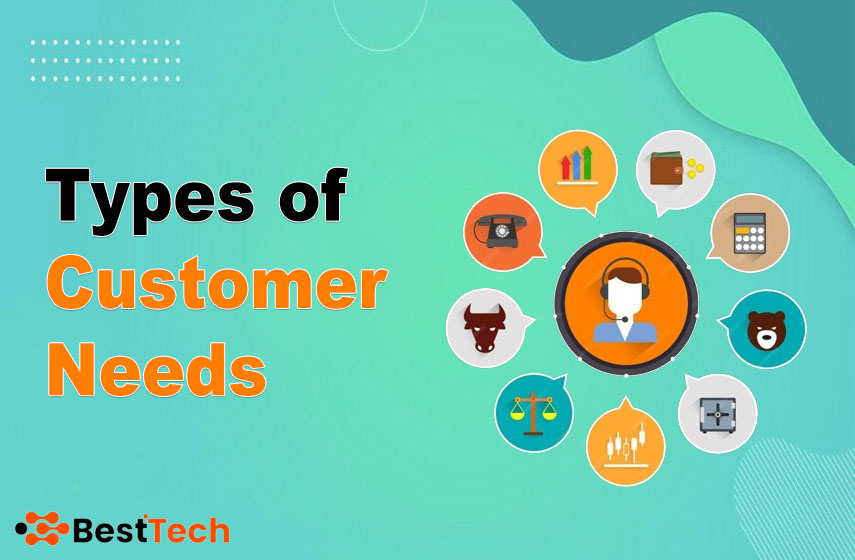Success depends on being able to recognize and satisfy customers wants. Customers are vital to any business, and each customer or organization has different needs. It is essential to recognize and cater to these various client needs to build lasting relationships, develop brand loyalty, and eventually attain the growth of an organization. Here, we discuss client needs more broadly than just what they require. Everything from office and retail locations to product improvements and strategically placed marketing is up for discussion.
Popular Types of Customer Needs
Here, we explain the various customer’s needs, shedding light on the complexity and richness of customer’s preferences.
Functional Needs
The most basic kind of customer requirement is a functional need. These requirements are based on the main objective of a product or service. Customers expect a product or service to carry out a particular task or address a particular issue. For instance, a client purchasing a smartphone hopes that it will operate multiple apps, make calls, and send messages without any issues. The foundation of any business is satisfying functional demands.
Emotional Needs
Customers have emotional needs in addition to fundamental practical requirements. These requirements are frequently connected to emotions, experiences, and an individual’s emotional attachment to a brand. Customers look for products and services that make them feel confident, encouraged, or sound. Consider luxury companies that are exceptional at satisfying the emotional requirements of their clients by creating a sense of exclusivity and social standing.
Social Needs
Because we are naturally social, our purchasing decisions are often driven by social demands. Customers might purchase products or services to identify with a specific group, to express their identity, or to convey their ideals. People could choose a particular car brand because it matches their social status or buy eco-friendly goods to demonstrate their dedication to environmental protection. Also, businesses utilize facebook to interact with customers.
Convenience Needs
In this era of technology, accessibility has grown into an essential need for customers. Customers are happy to pay more for products and services that make their lives easier and save time. Companies like Amazon have capitalized on this by offering speedy delivery services through Amazon Prime, catering to the convenience needs of their customers.
Price Related Needs
Cost can often be the most important factor for consumers. Customers who are price-conscious look for value and affordability. They are focused on achieving a balance between quality and price, rather than just finding the cheapest alternative. Businesses need to comprehend this market sector and provide competitive price plans.
Support Needs
Customers often require support before, during, and after making a transaction. Rapid and efficient customer support is essential to satisfying these needs. Whether it’s a comprehensive FAQ section on a website, a responsive customer service hotline, or a user-friendly return policy, providing support can significantly enhance the customer experience.
Ethical and Sustainable Needs
Growing numbers of customers emphasize ethical and sustainable behaviors and products in today’s world of socially and ecologically sensitive consumers. They want to support organizations that share their beliefs, such as those who employ fair labor practices, use eco-friendly materials, or support charitable causes.
Educational Needs
Specific industries must address customers’ educational needs, especially those with complex products or services. This involves providing information, resources, and guidance to help customers make informed decisions. Technology companies often offer online tutorials and documentation to help users navigate their products effectively.
How to Identify the Needs of Customers
Market Research
The foundation of comprehending client wants is market research. It involves gathering and studying information about your target market, rivals, and market trends. You can design surveys and questionnaires that gather direct feedback from clients. These can be shared via various platforms, such as your website, social media, and email.
You can also set up focus groups to facilitate in-depth talks with a small group of clients. This approach may offer priceless qualitative information. Track user behavior on your website using tools like Google Analytics. You may modify your products using this data to identify trends and preferences.
Customer Feedback
Understanding your consumers’ demands requires listening to them. Encourage feedback from a variety of sources. Your customer care staff should be taught to hear the complaints and suggestions of customers actively. Record the problems and concerns, and Check out social media sites and online reviews to see what others say about your products or services. To make it simple for clients to express their ideas, include feedback forms in your products, services, and website.
Data Analysis
Data analysis techniques, such as putting CRM systems in place to monitor customer interactions and transactions, can give valuable insights into customer behaviour and preferences. Using big data techniques to analyze huge data sets and identify purchasing patterns and trends can help reveal untapped customer insights. You can run A/B tests on your website or marketing initiatives to determine what appeals to your audience the most.
Conclusion:
The success of every company depends on its ability to identify and satisfy client demands. Customers have diverse tastes, and it’s important to cater to their wide range of demands, from the practical and emotional to the social and ethical. Businesses may build customer loyalty, expand their customer base, and stay in business for the long haul if they focus on meeting these demands. Understanding and meeting the ever-changing needs of your customers requires the use of techniques like as market research, consumer feedback, and data analysis. Eventually, in an increasingly competitive environment, organizations that are responsive to their customers’ ever-changing requirements will succeed, assuring the profitability of the firm and the happiness of its consumers.

